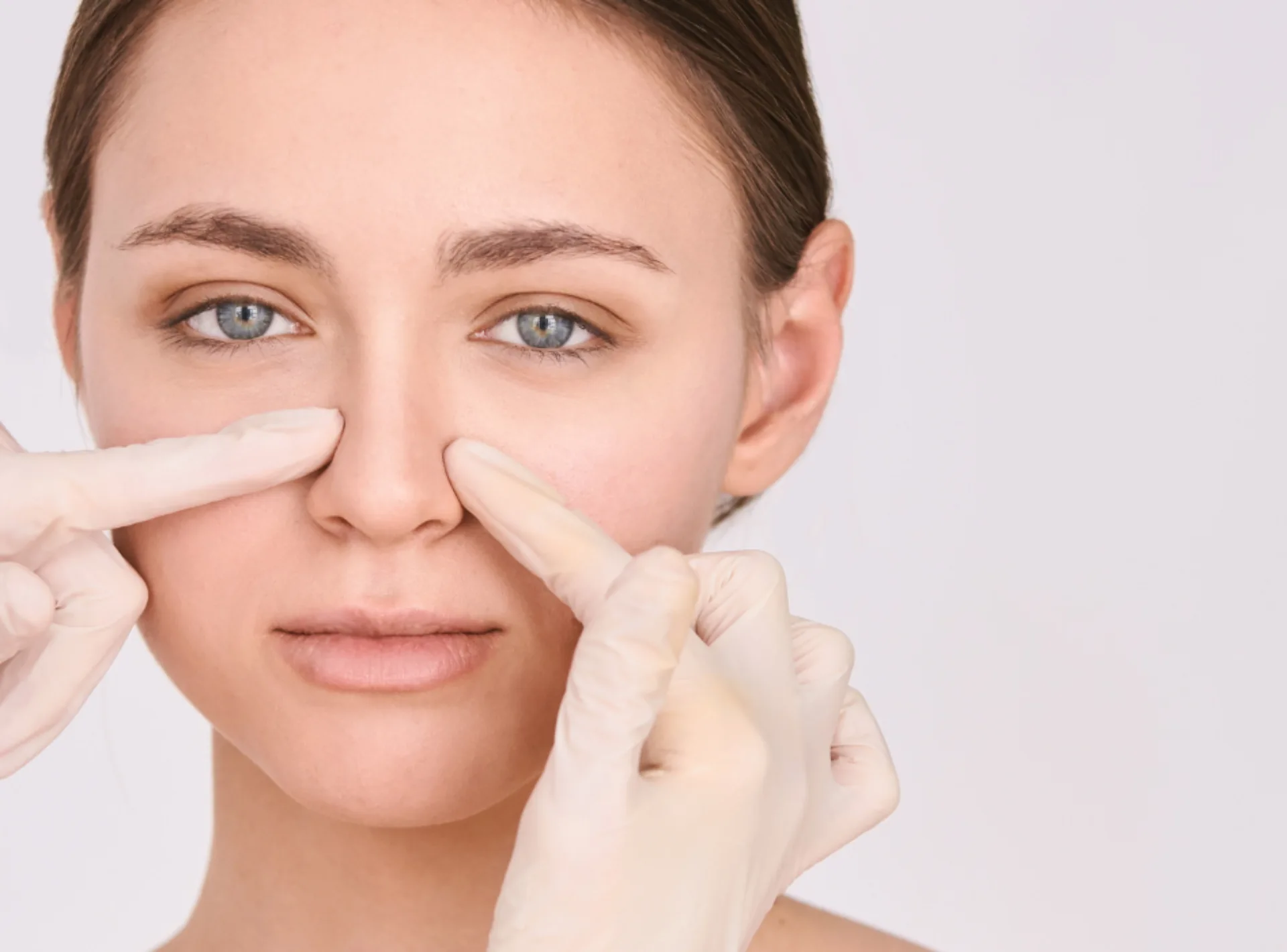Rhinoplasty, also known as a nose job, is a procedure that improves the appearance and functionality of the nose. However, as with any surgery, recovery is critical to achieving the best possible results. In this guide, we will walk you through the necessary steps for a smooth rhinoplasty recovery. From swelling management to determining when to resume daily activities, this guide by Perfect Doctors Clinic in Dubai will help you navigate the process with confidence, ensuring you achieve your desired outcome with the assistance of Perfect Doctors Clinic expert care.
Rhinoplasty In Dubai
Rhinoplasty in Dubai is a highly sought-after cosmetic surgery that reshapes and enhances the nose to achieve better facial balance and harmony. The procedure, performed by experienced plastic surgeons, addresses concerns such as bumps, wide bridges, drooping tips, or breathing difficulties. Patients can expect natural-looking, long-lasting results with minimal downtime.
BOOK AN APPOINTMENT TODAY
What Is Rhinoplasty?
Rhinoplasty is a surgical procedure that aims to reshape or reconstruct the nose. It fulfills both aesthetic and functional requirements. Aesthetically, it allows you to adjust the size, shape, or proportions of your nose to better match your facial features. Functionally, it can help with breathing problems caused by structural issues like a deviated septum. Depending on the patient’s needs, this procedure can improve nasal function as well as appearance.
Differences Between Rhinoplasty Types
Various reasons lead to rhinoplasty procedures. This is the most common type of rhinoplasty. It improves facial harmony by changing the nose’s shape, size, or symmetry. People like this procedure because it smooths out bumps, narrows wide bridges, and balances the tip of the nose. Functional rhinoplasty fixes structural problems like a deviated septum, collapsed nasal passages, or pre-existing airflow problems to make breathing better. This kind corrects the nose’s function and appearance. Finally, revision rhinoplasty fixes a nose job that didn’t work or its problems. Asymmetry, scar tissue, and breathing problems make this more difficult and need a skilled surgeon. For cosmetic, functional, or corrective reasons, each rhinoplasty is unique.
Importance Of Understanding Nose Job Recovery
Understanding the rhinoplasty recovery process is critical for patients because it has a direct impact on the procedure’s outcome. The healing phase consists of specific stages, such as reducing swelling, managing discomfort, and following strict postoperative instructions. Being informed allows patients to set reasonable expectations and avoid complications such as infection or prolonged swelling. Proper recovery practices, such as sleeping on your back with two pillows, avoiding smoking or being in a room with smokers, going to follow-up appointments, and avoiding strenuous activities, are critical to achieving the desired results and long-term success.
Rhinoplasty Recovery Time
The general recovery period for rhinoplasty varies from patient to patient, but it usually follows a consistent timeline. The majority of initial healing, including reduced swelling and bruising, occurs within the first two to three weeks. Patients can usually resume normal activities, such as work, after 15-20 days, but strenuous activities should be avoided for several weeks and up to four months. For primary cases, full recovery can take up to a year after all swelling has subsided and the final shape of the nose becomes visible.
Recovery time after a nose job in Dubai varies depending on the type of rhinoplasty performed and the surgical techniques used. Open rhinoplasty, which involves an incision across the columella (the skin between the nostrils), may take slightly longer to recover due to the more extensive tissue manipulation. The initial swelling and bruising are usually more pronounced (bruising is typically caused by bone manipulation, such as osteotomies), and patients can expect to see results in about 3-4 weeks, with full recovery taking up to a year. In contrast, closed rhinoplasty, which involves incisions inside the nostrils, usually results in a faster recovery. Closed rhinos have less swelling on the tip of the nose and nostrils, but if bones are broken, the recovery time is nearly identical.
The main distinction between individuals is that not all patients require reconstruction of all nose structures. A personalized treatment plan and operational approach should concentrate on addressing only the specific structures that require improvement for each patient.
MEET THE EXPERT DOCTOR
Factors Affecting Recovery Time
Several factors can influence nose job recovery time. Here are the major ones:
- Surgical complexity: More invasive procedures, such as those involving significant reshaping or structural corrections, typically require a longer recovery time than simpler cosmetic adjustments. For example, cartilage surgeries and bone adjustments frequently result in increased swelling and a longer healing period.
- Patient’s age and health: Younger, healthier people tend to heal faster. Smoking, alcohol consumption, and overall fitness can all contribute to a slower recovery. Older patients or those with preexisting health conditions may also have a longer recovery period.
- Post-operative care: Following the surgeon’s instructions, such as avoiding strenuous activities, managing swelling, and attending follow-up appointments, can have a significant impact on the speed and quality of your recovery. Noncompliance with these instructions can result in complications and prolong the recovery period.
- Skin type: Patients with thicker skin may experience more swelling and take longer for the nose to settle into its final shape, particularly at the tip.
Rhinoplasty Recovery Timeline
This is a breakdown of the rhinoplasty recovery timeline. Each stage has its own set of guidelines to help manage swelling and bruising while also promoting healing. Following your surgeon’s instructions and being aware of these phases will ensure a smoother recovery process after refining the unwanted nose shape:
- First week post-surgery: Swelling and bruising are most noticeable in the first week after rhinoplasty, especially around the nose and eyes. It is common to experience discomfort, congestion, and minor bleeding. This phase entails keeping the head elevated, applying cold compresses, and taking prescribed pain relievers. Patients are typically advised to rest and avoid strenuous activities.
- Weeks 2-4: Swelling and bruising go down significantly between the second and fourth weeks. By the end of this period, many patients are ready to return to work and light daily activities, though strenuous exercise should still be avoided. During this time, the nose’s shape begins to clear up, though the tip may still be swollen. During this time, significant milestones include the removal of nasal splints and the gradual reduction in discomfort.
- Months 1-6: Between months 1 and 6, the nose’s final shape emerges as the swelling subsides. By the third month, approximately 95% of the swelling has subsided, though minor swelling, particularly at the tip of the nose, can last up to six months. During this phase, patients are able to resume all normal activities, including exercise, and the surgical results are visible. Full results are typically seen after 6 to 12 months, when all residual swelling has subsided.
Nose Job Recovery Bruising
Bruising after rhinoplasty occurs as a result of the trauma caused to the blood vessels beneath the skin during surgery. When the nasal bones or cartilage are manipulated, minor blood vessels rupture, allowing blood to pool beneath the skin. This causes the appearance of bruising, particularly around the eyes.
Cold compresses applied to the nose’s surrounding areas can help manage and reduce bruising and swelling. Keeping the head elevated, especially while sleeping, helps to reduce blood flow to the face, which can reduce swelling and bruising. Avoid blood thinners and supplements before and after surgery.
It is critical to monitor the bruising for any indications of complications. If the bruising worsens significantly after the first week or is accompanied by severe swelling, redness, or fever, it may be the result of an infection or a hematoma, and you should seek medical attention right away.
Tips For A Faster And Smoother Recovery
To ensure a faster and smoother recovery from a nose job, seek out the best plastic surgeon in Dubai and carefully follow their instructions. This includes keeping your head elevated, taking prescribed medications, and avoiding strenuous activities. Ignoring these guidelines can prolong recovery or cause complications. Adoption of a healthy lifestyle is also important. Proper nutrition, staying hydrated, and avoiding smoking and alcohol all help the body heal and reduce inflammation. Finally, managing your expectations is critical. While the initial swelling subsides in the first few weeks, the final results can take up to a year, so patience is essential for a successful outcome.
Your Complete Rhinoplasty Healing Guide
Rhinoplasty recovery is a gradual process that necessitates patience and strict adherence to established guidelines. Following your surgeon’s instructions, maintaining a healthy lifestyle, and being realistic about recovery milestones will help you have a smoother healing journey. Swelling and bruising are normal, but they fade over time, allowing you to see the final results as the nose heals completely over several months. If you notice excessive swelling, infection symptoms, or anything unusual, contact your surgeon right away to avoid complications.
Best Plastic Surgeon In Dubai For Rhinoplasty
Best Plastic Surgeon in Dubai for Rhinoplasty is available at Perfect Doctors Clinic,combining expertise and innovation to offer patients both aesthetic refinement and improved nasal function. Rhinoplasty is also called a nose job. It is a surgical method for reshaping or resizing the nose. Rhinoplasty goes beyond aesthetics, improving not only the shape and appearance of the nose but also addressing functional issues. It can correct a deviated septum, improve airflow, and alleviate breathing issues, giving patients a healthier and more confident life while also improving their appearance.
















































